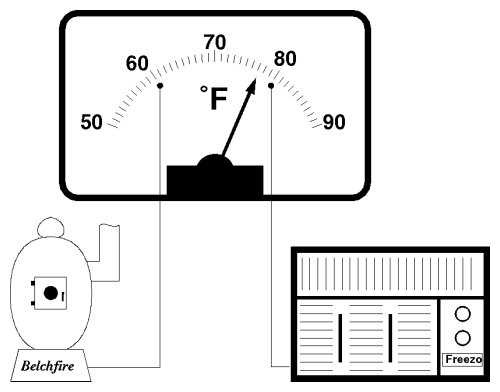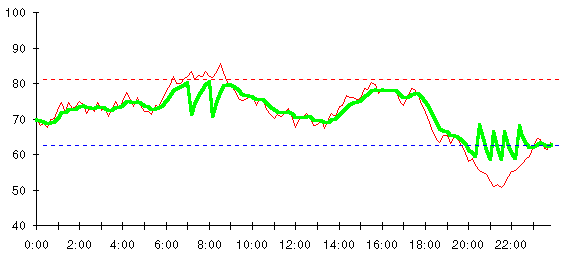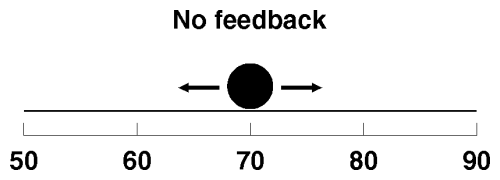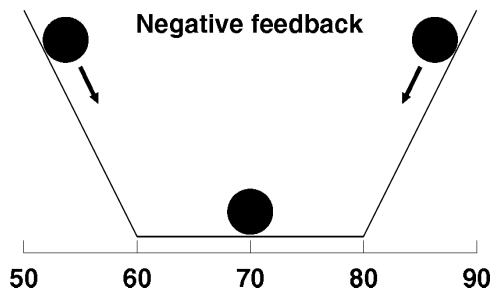
Whenever the ``Too cold!'' light comes on, we could stoke up the furnace, and when ``Too hot!'' was lit, crank up the air conditioner. But why get personally involved? We can wire the furnace and air conditioner right up to the thermometer in place of the blinkin' lights.

Whenever the temperature drops to 60 or below, the heater starts up and keeps on running until it's raised the temperature above 60, switching it off. When the needle hits 80, the air conditioner whirrs into action and wafts a welcome, cooling zephyr our way until the temperature falls back below that mark.

Finally, we've achieved control over the temperature. The heavy line on this chart is the indoor temperature. As long as the outside temperature stays between 60 and 80 degrees, the indoor temperature follows it. As soon as the temperature begins to drift outside this range, the furnace or air conditioner pulls the temperature back toward the goal of 70° .
Engineers call this ``negative feedback.'' The phrase is important, so let's pick it apart word by word. ``Feedback'' refers to the process by which the measurement (temperature) causes actions (starting the furnace or air conditioner) which, in turn, affect the quantity we're measuring (by heating or cooling the room). The feedback is ``negative'' because the action opposes the condition that triggers it. When it's too cold, the furnace heats up the place. When it's too hot, the air conditioner comes on and cools things off--negative feedback.
Another way of thinking about feedback is in terms of the constraints it places on the freedom of the system to change. Think of the temperature the thermostat is controlling as a ball rolling on a surface. As long as no feedback is applied, the ball is free to roll whenever it likes: the surface can be thought of as a completely flat plain, like this.

When it gets warmer outside, the ball, representing room temperature, gets pushed to the right, toward higher readings. When it cools off, the ball is dragged back to the left. In neither case does the ball ``push back''; it moves totally at the whim of the weather.
Providing negative feedback with a thermostat changes the lay of the land. Instead of the temperature roaming freely like a ball on a flat surface, now it's confined within a valley.

The flat floor of the valley represents temperatures between 60 and 80 degrees. Within this range the ball, representing the temperature, is free to follow the outside temperature as before. Once it reaches the point where the thermostat starts heating or cooling the room, however, it encounters a steep slope. As long as the heating or cooling capacity exceeds the rate heat can leak through the walls from outdoors, the temperature will remain confined to the desired range. This viewpoint makes the stability conferred by negative feedback self-evident.
Negative feedback is at the heart of every stable, self-regulating system. If a company raises prices too high, people stop buying and soon the company cuts the price to increase sales. When there's plenty of rabbits, the wolves eat well, multiply, and before long more rabbits get eaten and they aren't so abundant. When your car starts veering into the left lane, you turn the wheel to the right. When you're feeling tired, you get more sleep. Negative feedback is ubiquitous, yet its profound consequences are often overlooked for this very reason. To understand them better, consider what happens when feedback goes bad.
By John Walker